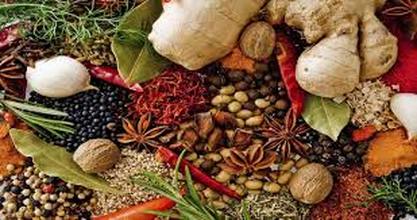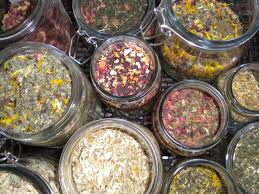Function of Ayurvedic Herbs

Ayurveda is the traditional medicinal form, prevalent in India since 2000 B.C. The Ayurvedic treatment is entirely based on herbs, which have certain medicinal value or property.
In the ancient times, the Indian sages believed that Ayurvedic herbs are one-stop solutions to cure a number of health related problems and diseases. They conducted thorough study about the same, experimented with herbs to arrive at accurate conclusions about the efficacy of different plants and herbs that have medical value.
Most of the Ayurvedic herbs, thus formulated, are free of side effects or reactions. This is the reason why Ayurveda is growing in popularity across the globe. The Ayurvedic herbs that have medicinal qualities provide rational means for the treatment of many internal diseases, which are otherwise considered incurable in other systems of medicine. Go through the following lines to learn all about the importance of herbs in order to lead a healthy, peaceful and disease-free life.
|
Ayurveda Anti-Aging Herbs
Antioxidants
|
Energy Boosters
Cholesterol
Detoxification
|
Immunity
Brain Function
Sleep Support
|
Importance Of Herbs in Ayurveda
- Many herbs are used to alter or change a long-standing condition by eliminating the metabolic toxins. Also known as 'blood cleansers', certain herbs improve the immunity of the person, thereby reducing conditions such as fever. Herbs such as ginseng, aloe, sandalwood, red clover, burdock, bayberry, black pepper, cinnamon, myrrh, and safflower are known for their alterative properties, which are used to heal wounds, sores and boils as well.
- In order to neutralize the acid produced by the stomach, herbs such as marshmallow root and leaf are used. They serve as antacids. The healthy gastric acid needed for proper digestion is retained by such herbs.
- Antibiotic herbs like turmeric are useful in inhibiting the growth of germs, harmful microbes and bacteria. Turmeric is widely used as a home remedy to heal wounds and cut.
- To reduce fever and the production of heat caused by the condition, certain antipyretic herbs such as black pepper, sandalwood, safflower and brihati are recommended by Ayurvedic practitioners.
- An important medical property of herbs is to serve as antiseptic. Aloe, sandalwood, turmeric, chitrak and gokshura are commonly used antiseptic herbs that are high in their medicinal value.
- Since ages, Indian sages have been using anti-venomous herbs, which act against poisonous matter from animals such as snake.
- Certain aromatic herbs like cardamom and coriander are renowned for their appetizing qualities. Other aromatic herbs such as cloves, peppermint and turmeric add a pleasant aroma to the food, thereby increasing the taste of the meal. They serve as digestives and condiments for the food as well.
- Apart from being aromatic, sandalwood and cinnamon are also great astringents. Sandalwood is especially used in arresting the discharge of blood, mucus etc.
- Certain aromatic plants such as aloe, barberry, golden seal and chirayat are used as mild tonic. The bitter taste of such plants reduces toxins in blood. They are helpful in destroying infection as well.
- Ayurvedic practitioners recommend calmative herbs, which provide a soothing effect to the body. They are often used as sedatives.
- Herbs such as Chamomile, chrysanthemum, coriander, fennel, peppermint, and spearmint, ajwan, basil, calamus, cardamom, cinnamon, ginger, and turmeric are helpful in promoting good blood circulation. Therefore, they are used as cardiac stimulants.
- Certain herbs have disinfectant property, which destroys disease causing germs. They also inhibit the growth of pathogenic microbes that cause communicable diseases. Arka, gudachi and katuka are the examples of disinfectant herbs.
- Certain cough syrup ingredients like ginger and cloves are known for their expectorant property, which promotes the thinning and ejection of mucus from the lungs, trachea and bronchi. Cardamom, eucalyptus, wild cherry and cloves are also expectorants.
- In order to increase the activity of a system or an organ, certain herbs like camphor, cayenne, myrrh, guggul and gotu kola are used as stimulants.
- Herbs serve as tonic. A wide variety of herbs including guduchi, katuka, golden seal, aloe, barberry and bala are used as tonics or chief ingredients of a tonic. They can also be nutritive and rejuvenative.
- Honey, turmeric, marshmallow and licorice can effectively treat a fresh cut and wound. They are termed as vulnerary herbs
Ayurvedic Herbology
The science of Ayurveda is a unique holistic system, based on the interaction of body, mind and spirit. The treatment of Ayurveda is based on Indian herbs, which have a healing energy. Herbs have a unique flavor and intoxicating aroma, which contribute to their medicinal quality. The science of life - Ayurveda - has focused on the use of herbs as to lead a healthy life, free of diseases. Specific emphasis is given on the preparation and storage of herbs, followed since the ancient period, when Indian sages used herbs for curing a number of diseases.
The herbs used in Ayurvedic are different from each other, in terms of a number of factors. A number of herbs vary according to their taste, while others are categorized according to their medicinal value. There are mainly three different categories of herbs: mild, strong and toxic. Herbalists mainly use mild herbs, because they have nutritive, energetic and therapeutic values without causing reactions or toxic effects. Use of herbs is regarded as the friendly way of treatment, because very less or no side effects are associated with them.
Today, Ayurveda and its herbal treatment flourishes side by side with Homeopathic, Unani Tibb and Western conventional medicine and is actively encouraged as an inexpensive alternative to drugs. Ayurvedic herbal treatment is one of the most natural ways of curing a disease, as it has no side effects and after-treatment complications. That's why it is regarded as the most safest and inexpensive healing. In this section, we have given detailed description of the medicinal and herbal properties of Ayurvedic herbs.
Effects of Ayurvedic Herbs
A number of herbs are used as medicines in Ayurveda - the science of life. Since ages, herbs have been known to help relieve aches and inflammation. The Ayurvedic rishis in the ancient times used herbs and mixed them with other herbs to create medicines that could treat many deadly diseases. Some of them proved to be elixirs. The herbs used in Ayurveda have diverse chemical formation.
Types of Ayurvedic Herbs: Ayurveda is the ancient science of life, which aims to promote a healthy lifestyle, free of diseases. The Ayurvedic rishis in the ancient times have discovered the medicinal use of many herbs, which are effective in curing a number of diseases that are otherwise difficult to get rid of. The herbs have been in use since the ancient times, when people were not familiar with allopath and other forms of treatment and resorted to the herbs and Ayurvedic medicines that were available.
Significance of Ayurvedic Herbs: Ayurveda is the traditional medicinal form, prevalent in India since 2000 B.C. The Ayurvedic treatment is entirely based on herbs, which have certain medicinal value or property. In the ancient times, the Indian sages believed that Ayurvedic herbs are one-stop solutions to cure a number of health related problems and diseases.
Properties of Ayurvedic Herbs: Ayurveda is a vast and ancient medicine science. The basic principle of Ayurvedic treatment is to cure the causative element of the disease from its root instead of suppressing its symptoms.
The Ayurvedic treatment is largely based on the natural elements and herbs. All the Ayurvedic medicines are prepared by using these herbs in prescribed quantities. The properties of herbs and effects of the doshas are taken into account in designing the Ayurvedic herbal formulas.
The science of Ayurveda is a unique holistic system, based on the interaction of body, mind and spirit. The treatment of Ayurveda is based on Indian herbs, which have a healing energy. Herbs have a unique flavor and intoxicating aroma, which contribute to their medicinal quality. The science of life - Ayurveda - has focused on the use of herbs as to lead a healthy life, free of diseases. Specific emphasis is given on the preparation and storage of herbs, followed since the ancient period, when Indian sages used herbs for curing a number of diseases.
The herbs used in Ayurvedic are different from each other, in terms of a number of factors. A number of herbs vary according to their taste, while others are categorized according to their medicinal value. There are mainly three different categories of herbs: mild, strong and toxic. Herbalists mainly use mild herbs, because they have nutritive, energetic and therapeutic values without causing reactions or toxic effects. Use of herbs is regarded as the friendly way of treatment, because very less or no side effects are associated with them.
Today, Ayurveda and its herbal treatment flourishes side by side with Homeopathic, Unani Tibb and Western conventional medicine and is actively encouraged as an inexpensive alternative to drugs. Ayurvedic herbal treatment is one of the most natural ways of curing a disease, as it has no side effects and after-treatment complications. That's why it is regarded as the most safest and inexpensive healing. In this section, we have given detailed description of the medicinal and herbal properties of Ayurvedic herbs.
Effects of Ayurvedic Herbs
A number of herbs are used as medicines in Ayurveda - the science of life. Since ages, herbs have been known to help relieve aches and inflammation. The Ayurvedic rishis in the ancient times used herbs and mixed them with other herbs to create medicines that could treat many deadly diseases. Some of them proved to be elixirs. The herbs used in Ayurveda have diverse chemical formation.
Types of Ayurvedic Herbs: Ayurveda is the ancient science of life, which aims to promote a healthy lifestyle, free of diseases. The Ayurvedic rishis in the ancient times have discovered the medicinal use of many herbs, which are effective in curing a number of diseases that are otherwise difficult to get rid of. The herbs have been in use since the ancient times, when people were not familiar with allopath and other forms of treatment and resorted to the herbs and Ayurvedic medicines that were available.
Significance of Ayurvedic Herbs: Ayurveda is the traditional medicinal form, prevalent in India since 2000 B.C. The Ayurvedic treatment is entirely based on herbs, which have certain medicinal value or property. In the ancient times, the Indian sages believed that Ayurvedic herbs are one-stop solutions to cure a number of health related problems and diseases.
Properties of Ayurvedic Herbs: Ayurveda is a vast and ancient medicine science. The basic principle of Ayurvedic treatment is to cure the causative element of the disease from its root instead of suppressing its symptoms.
The Ayurvedic treatment is largely based on the natural elements and herbs. All the Ayurvedic medicines are prepared by using these herbs in prescribed quantities. The properties of herbs and effects of the doshas are taken into account in designing the Ayurvedic herbal formulas.

Thank You To Our Friends at SA Herbal
http://www.saherbal.org/about
http://www.saherbal.org/about
